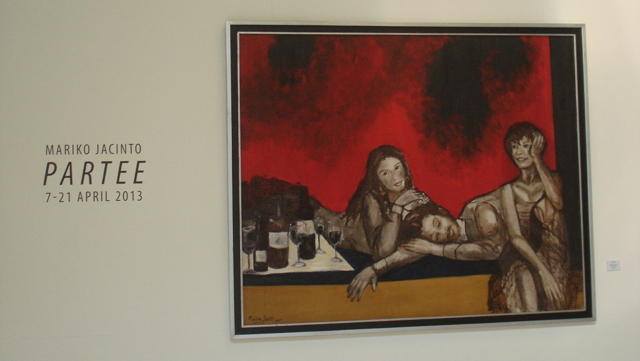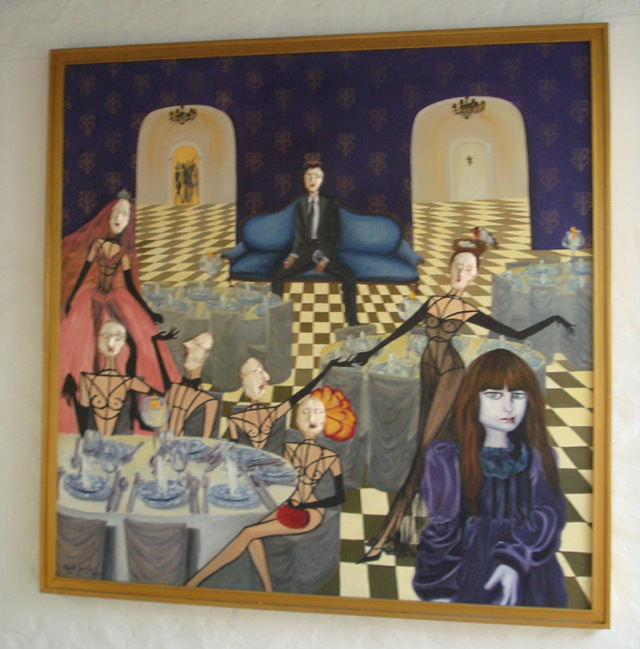SUMMARY
This is AI generated summarization, which may have errors. For context, always refer to the full article.
MANILA, Philippines – Mariko Jacinto‘s current exhibit “Partee” at the picturesque Pinto Art Museum in Antipolo City welcomes us to sights and states of people in various modes of carousal within soiree settings, mostly from her experience of Manila’s social party scenes.
In “Peaking” (2005) we find an ocean of loud red background with two women and a man in sepia caricature. While the women are shown fully awake and smiling, the man is half lying on the table, where the party drinks are displayed and consumed at the peak of party night.
In “Alta de Ciudad” (2013) we see a surreal portrait of 8 people at close range, wining and dining in a posh hall. Laying bare the elements – black walls, checkered floors, a man seated like an inebriated king on a blue sofa, and 6 women depcited with stick bodies and thickly-impastoed faces – all add up to the phantasmagoria of this party portrait. A 7th Causcasian woman appears on the right side, wearing a silky black dress and rendered in semi-realist fashion. We clearly sense the travesty of high fashion life throbbing behind this interesting, almost cynical caricature.
In “Back to Reality” (2012) we see a woman holding a cup of tea while looking out her window, reminiscent of that hangover after a party’s frenzy.
Using oil on canvas, Mariko depicts figurative paintings in expressionist — sometimes realist — styles, the latter especially shown in her profiles and portraits. The artist’s nuanced sensitivity to the moods and feelings of her subjects easily comes through, highlighting their humanity and the charade of the socialites’ life.
Other portraits from her earlier works are more realistic in style as in “Rumination” (2000) where a white man in a green shirt rests his head on one hand, as if in deep thought. In “The Observer” (2001), a woman rests on a chair as if watching things from where she is.
Born to a Japanese mother and a Filipino father, Mariko studied anatomy and figure painting with Sam Adoquei and still life painting with the National Academy of Design in New York. She straddles life between the Philippines and New York, where she spends time to visit her daughter and join group exhibitions.
A practicing Buddhist, Mariko imbues her paintings with compassion, as spelled in her artist’s bio, saying that her paintings of the club life shows an “undercurrent of human sympathy.”
Love watching an artist at work? Here’s a video of Mariko Jacinto working in Paco, Manila:
In fact, Mariko’s first triumph as a painter was premiered in Boston Gallery, Manila in 1995, with her exhibit “The Buddha Land.” Among the works presented here was a lyrically-rendered painting called “Dreaming Monk,” with an orange-robed monk sleeping under an impastoed canopy of orange trees, behind which hovers the benevolent face of an orange Buddha.
In her artist’s statement, Mariko speaks of the “humanist outlook and the doctrine of imparmanence” in her works, principles that are reminiscent of Buddhist practice.
Beyond the party life, Mariko gifts us with an understated spiritual eyesight amidst the delusions behind social shindigs in all their short-lived luster. – Rappler.com
‘Partee’ runs at the Pinto Art Museum, Grand Heights, Antipolo until April 21. For details, call 697-1015 or visit their Facebook page.
Rina Angela Corpus is an assistant professor of Art Studies at the College of Arts and Letters, University of the Philippines. She survived Sandy while on special detail in New York in October 2012. She practices the healing arts of shibashi-chigong and Raja Yoga meditation. Her poems have been featured in Mad Swirl, Philippine Collegian, Philippines Free Press, and Tayo Literary Magazine.
Add a comment
How does this make you feel?


There are no comments yet. Add your comment to start the conversation.